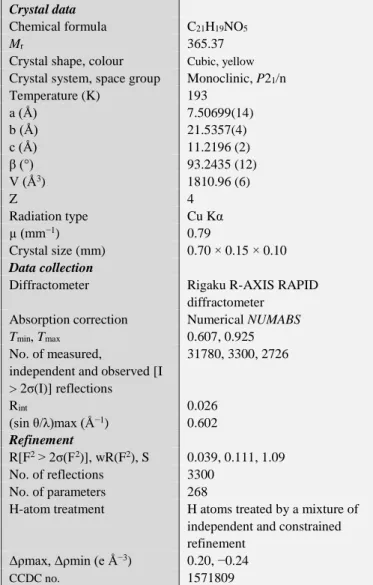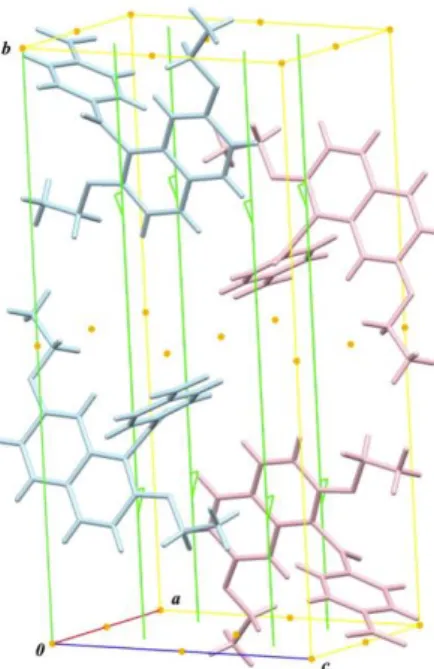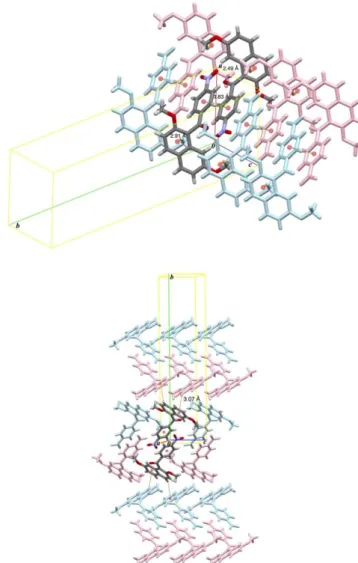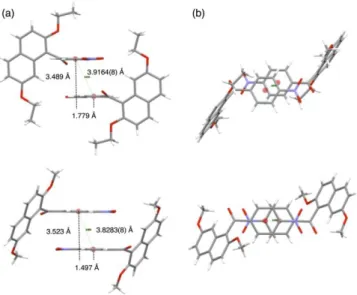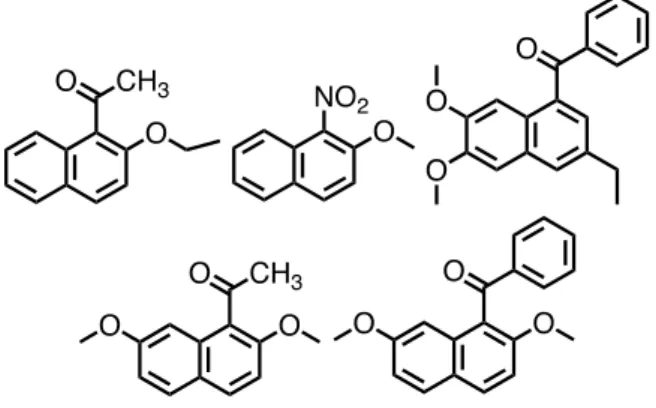DIMERIC MOLECULAR AGGREGATION MOTIF IN CRYSTAL OF 2,7-DIETHOXY-1-(4-NITROBENZOYL)NAPHTHALENE:
CORRELATION OF SINGLE MOLECULAR STRUCTURE, MOLECULAR ACCUMULATION STRUCTURE AND NON-
COVALENT-BONDING INTERACTIONS
Shinji Ohisa,
[a]Mayumi Saeki,
[a]Hirokazu Shiomichi,
[a]Noriyuki Yonezawa,
[a]and Akiko Okamoto
[a]*Keywords: Centrosymmetric dimeric molecular aggregate, molecular motif, non-classical hydrogen bonds, … stacking interaction Crystal structure of 2,7-diethoxy-1-(4-nitrobenzoyl)naphthalene C21H19NO5, is reported and discussed on the characteristics of the spatial organization of single molecule and molecular aggregation as contrasted with a homologous compound. The molecular structures of these compounds differ only in the kind of alkoxy group of 2,7-positions of the naphthalene rings, i.e., ethoxy groups for title compound and methoxy groups for homologue. In single molecular crystal structures of these compounds, 4-nitrobenzoyl group is non-coplanarly attached to the naphthalene ring. The molecules exhibit axial chirality, with either R or S stereogenic axis. The two pairs of the enantiomeric molecules are related by two-fold helical axis in the asymmetric unit of P21/n space group for title compound and P21/c one for homologue, showing the number of molecules (Z) is four for both compounds. In their molecular packing structures, (R)- and (S)- enantiomers are connected to each other by … stacking interactions, forming centrosymmetric dimeric molecular aggregates. However, the aggregation structures of the dimers are apparently different between title compound and homologue. The dimeric units of title compound are stacked into columnar structure with (sp2)C–H…O=C non-classical hydrogen bonds between identical enantiomers along a- axis. The columns are connected by (sp2)C–H…OEt non-classical hydrogen bonds between identical enantiomers along c-axis to give sheet-like aggregation spreading on ac-plane. The sheets are piled up through (sp3)C–H… non-classical hydrogen bonds between opposite enantiomeric molecules of next dimeric aggregates along b-axis giving layers. On the other hand, the dimeric molecular aggregates of homologue are connected into flattish column by (sp3)C–H…O=C non-classical hydrogen bonds and (sp3)C–H… non- classical hydrogen bonds between identical enantiomers. The columns are linked into waving plate through weak (sp2)C–H… non- classical hydrogen bonds. In title compound, difference between … stacking interactions and non-classical hydrogen bonds is smaller than homologue in contribution to the whole of molecular packing structure.
* Corresponding Authors Fax: +81-42-388-7291
E-Mail: aokamoto@cc.tuat.ac.jp
[a] Department of Organic and Polymer Materials Chemistry, Tokyo University of Agriculture and Technology, 2-24-16 Naka-machi, Koganei, Tokyo 184–8588, Japan
Introduction
To understand correlation between molecular structure and molecular aggregation is one of important themes for designing novel organic solid materials and organic molecular crystals.1-6 Crystal engineering often use a concept of supramolecular synthon7 for leading objective crystal structure. Supramolecular synthons are kinetically defined structural units that transfer the essential features of a crystal structure, and a critical assumption is that the synthon is a reasonable approximation to the whole crystal.
The closer the structure of a small synthon is to the actual crystal, the more useful is this entire concept. Although design of strong interactions leading robust synthon is one of important strategies in crystal engineering, supramolecular synthon is not universal concept from the perspective of understanding the correlation between molecular structure and molecular packing structure.
Because, organic molecules in crystal are linked by not only strong hydrogen bonds but also a number of weak hydrogen
ones including van der Waals interactions, non-classical hydrogen bonds whose C–H groups form with electron rich atom/group, and … stacking interactions. Studies on role and importance of the weak interactions have been received much attentions.8-11 On the other hand, investigation with the intense to understand and estimate the relative contribution to a whole of molecular aggregation has gradually progressed.12-14 One reason why is that a series of model compounds suitable for systematic investigations on weak interactions is difficult to obtain. The authors reported single molecular structures and the structural features of the molecular packing structures for roughly ninety compounds having 1,8-diaroylated naphthalene skeletons or the homologous/analogous structures via the Cambridge Structure Database (CSD).15-18
There are two common features in the crystals of 1,8- diaroylated naphthalene compounds, 1) two aroyl groups are non-coplanarly located to the 2,7-dialkoxynaphthalene core and oriented in an opposite direction with a few exceptional compounds bearing unidirectional-alignment of aroyl groups and 2) the molecular packing of 1,8-diaroylated 2,7- dialkoxynaphthalene compounds are mainly stabilized by weak hydrogen bonds, i.e., four kinds of non-covalent bonding interactions, (sp2)C–H···O=C non-classical hydrogen bonds, (sp3)C–H···O non-classical hydrogen bonds, C–H···π non-classical hydrogen bonds, and π···π stacking interactions are observed in decreasing order of
frequency. The features can be interpreted that the non- coplanarly accumulated aromatic rings structure disturbs formation of strong π…π stacking interactions. The authors also determined several crystal structures of 1-aroylated naphthalene compounds.19-21 They have non-coplanarly accumulated aromatic rings structure. The authors envision that 1-aroylated naphthalene compounds show similar structural features to 1,8-diaroylated naphthalene compounds, whereas they might have flexible spatial organization rather than the 1,8-diaroylated homologue.
Therefore, the authors planned to elucidate correlation between molecular structure and crystal structure of 1- aroylated naphthalene compounds by tracing non-covalent bonding interactions. The information should be complementary knowledge to a concept of supramolecular synthon. Herein crystal structure of 2,7-diethoxy-1-(4- nitrobenzoyl)naphthalene22 is reported and discussed correlation among molecular structure, molecular packing structure and effective non-covalent bonding interactions through comparison with the 1-aroylated naphthalene homologue, 2,7-dimethoxy-1-(4-nitrobenzoyl)naphthalane,19 and the related other compounds.
Experimental
Materials and methods
Aluminium chloride was of commercial quality and was used as received from Wako Pure Chemical Industries, Ltd., Japan, purity greater than 98%. 4-Nitrobenzoyl chloride was acquired from Tokyo Chemical Industry Co., Ltd., Japan, purity greater than 98% and purified by distillation under reduced pressure (135˚C/18 mmHg). Solvents were dried and purified using standard procedures.23 Synthetic methods and spectral data for starting material and homologue, 2,7-diethoxynaphthalene and 2,7-dimethoxy-1- (4-nitrobenzoyl)naphthalene, have been reported in literatures. 24, 19
Measurements
1H NMR spectra were recorded on a JEOL JNM-AL300 spectrometer (300 MHz). Chemical shifts are expressed in ppm relative to internal standard of Me4Si (δ 0.00). 13C NMR spectra were recorded on a JEOL JNM-AL300 spectrometer (75 MHz). Chemical shifts are expressed in ppm relative to internal standard of CDCl3 (δ 77.0). IR spectra were recorded on a JASCO FT/IR-4100 spectrometer (KBr tablet). High-resolution FAB mass spectra were recorded on a JEOL MStation (MS700) ion trap mass spectrometer in positive ion mode.
X-ray crystallography
For the crystal structure determination, the single-crystal of title compound was used for data collection on a four-circle Rigaku RAXIS RAPID diffractometer (equipped with a two-dimensional area IP detector). The graphite-mono- chromated Cu Kα radiation (λ = 1.54187 Å) was used for data collection. The lattice parameters were determined by the least-squares methods on the basis of all reflections with F2>2σ (F2). Crystal data, data collection and structure
refinement details are summarized in Table 1. All H atoms could be located in difference Fourier maps, but were subsequently refined in optimized positions as riding atoms, with C–H = 0.95 (aromatic) and 0.98 (methyl) and with Uiso(H) = 1.2 Ueq(C). For data collection: PROCESS- AUTO25; cell refinement: PROCESS-AUTO25; data reduction: CrystalStructure26; program(s) used to solve structure: SIR200427; program(s) used to refine structure:
SHELXL9728; molecular graphics: ORTEPIII29. The hydrogen bond geometries of title compound are listed in Table 2. Molecular structure of title compound with the atom-labelling scheme is displayed in Figure 1.
Table 1. Crystallographic data and structure refinement parameters of title compound.
Table 2. Hydrogen-bond geometry (Å, ˚).
Symmetry codes: (i) -x, 1-y, 1-z; (ii) 1+x, y, z; (iii) x, y, -1+z; (iv) - 1/2+x, 1/2-y, 1/2+z.
Crystal data
Chemical formula C21H19NO5
Mr 365.37
Crystal shape, colour Cubic, yellow Crystal system, space group Monoclinic, P21/n
Temperature (K) 193
a (Å) b (Å) c (Å)
7.50699(14) 21.5357(4) 11.2196 (2)
β (°) 93.2435 (12)
V (Å3) 1810.96 (6)
Z 4
Radiation type Cu Kα
µ (mm−1) 0.79
Crystal size (mm) 0.70 × 0.15 × 0.10 Data collection
Diffractometer Rigaku R-AXIS RAPID
diffractometer Absorption correction Numerical NUMABS
Tmin, Tmax 0.607, 0.925
No. of measured,
independent and observed [I
> 2σ(I)] reflections
31780, 3300, 2726
Rint 0.026
(sin θ/λ)max (Å−1) 0.602 Refinement
R[F2 > 2σ(F2)], wR(F2), S 0.039, 0.111, 1.09
No. of reflections 3300
No. of parameters 268
H-atom treatment H atoms treated by a mixture of independent and constrained refinement
Δρmax, Δρmin (e Å−3) 0.20, −0.24
CCDC no. 1571809
D―H…A D―H H…A D…A D―H…A
C13–H31B…O4ⅰ 0.99 2.59 3.2298(18) 122
C17–H17…O5ⅱ 0.95 2.46 3.3668(18) 161
C18–H18…O2iii 0.95 2.55 3.3706(16) 144
C20–H20…O3ii 0.95 2.47 3.3808(17) 160
C11–H11B…Cg2iv 0.96 2.71 3.5863(16) 148
C12–H12A…Cg1iv 0.96 2.87 3.813(2) 164
Synthesis of 2,7-diethoxy-1-(4-nitrobenzoyl)naphthalene To a 10 mL two-necked round-bottomed flask, 4- nitrobenzoyl chloride (41 mg, 0.22 mmol), aluminium chloride (32 mg, 0.24 mmol) and dichloromethane (0.5 mL) were placed. After stirring at 273 K for 15 min under nitrogen atmosphere, 2,7-diethoxynaphthalene (43 mg, 0.20 mmol) was added to the reaction mixture. After stirring for 24 h, the reaction mixture was poured into water (30 mL).
The resulting aqueous solution was extracted with chloroform (20 mL × 3). The combined organic extracts were washed with 2 M NaOH aq. (20 mL × 3) and brine successively. The organic layer thus obtained was dried over anhydrous MgSO4. The solvent was removed under reduced pressure to give a cake (quant.). The crude material was purified by column chromatography (silica gel, toluene).
Yellow cubic single crystals suitable for X-ray diffraction were obtained by crystallization from acetone (22.7 mg;
31% yield).
1H NMR (300 MHz, CDCl3): 1.02 (3H, t, J = 6.9 Hz), 1.38 (3H, t, J = 7.2 Hz), 4.01 (4H, q), 6.95 (1H, d, J = 2.4 Hz), 7.05 (dd, 1H, J = 9.0 Hz, 2.4 Hz), 7.10 (d, 1H, J = 9.3 Hz), 7.74 (d, 1H, J = 9.0 Hz), 7.89 (d, 1H, J = 7.5 Hz), 7.96 (d, 2H, J = 6.9 Hz), 8.28 (d, 2H, J = 9.0 Hz) ppm. 13C NMR
(75 MHz, CDCl3) : 14.63, 14.78, 63.61, 64.80, 102.71, 110.93, 117.64, 120.30, 123.82, 124.50, 130.02, 130.10, 132.54, 133.36, 143.97, 150.24, 155.59, 158.93, 196.67 ppm.
IR (KBr): 1671 (C=O), 1623, 1597, 1523, 1514 (Ar, naphthalene), 1346(N-O), 1279 (O-Et) cm-1. HRMS (FAB;
m-NBA) m/z : [M+H]+; calcd for C21H20NO5, ; 366.1341, found 366.1337. m. p. = 452–453 K.
Results and discussion
Figure 1 exhibits single molecular structure of title compound.22 The aroyl group is non-coplanarly situated against the naphthalene ring. The interplanar angle between 4-nitrobenzene ring and 2,7-diethoxynaphthalene ring is 81.99(5)˚ [torsion angles = 112.12(15)˚ (C2–C1–C15–O3) and 114.48(14)˚ (C9–C1–C15–C16)]. The plane of the bridged carbonyl group [C–(C=O)–C] is tilted to both 4- nitrobenzene ring and the naphthalene ring [dihedral angles;
26.80(7)˚ and 67.43(6)˚, respectively]. On the other hand, the nitro group is coplanarly attached to the 4-nitrobenzene ring [torsion angles = 0.21(19)˚ (O4–N1–C19–C18) and - 179.68(13)˚ (O5–N1–C19–C18)]. Two ethoxy groups at 2,7-positions of the naphthalene ring are oriented in different directions, i.e., the ethoxy group at 7-position of the naphthalene ring turns toward outer side of molecule, and that at 2-position comes closer to inner part of molecule.
Contrary to the achiral nature of title molecule in solution, the molecules in crystal exhibit atrope isomerism brought about by molecular stereogenic axis of carbon–carbon bond between the carbonyl moiety and the naphthalene ring.
Therefore, a pair of (R)- and (S)-enantiomeric molecules exists in the crystal. The two pairs of the enantiomeric molecules are related by two-fold helical axis in the asymmetric unit of P21/n space group, exhibiting the number of molecules (Z) in a unit cell is four (Figure 2).
In molecular packing, (R)- and (S)-enantiomeric molecules are linked centrosymmetrically (Figure 3).
Between the paired enantiomeric molecules, (4-
nitrophenyl)…(4-nitrophenyl) stacking interaction [centroid–centroid distance Cg3…Cg3 = 3.92 Å; Cg3 = C16–C21 rings], a pair of ([ethoxy]methylene)C–H…O=N non-classical hydrogen bonds [C13–H13B…O4 = 2.59 Å], and a pair of weak (naphthalene)C–H…O=N non-classical hydrogen bonds [C8–H8…O4 = 2.68 Å] are observed as effective non-covalent bonding interactions.
Figure 1. Molecular structure of 2,7-diethoxy-1-(4- nitrobenzoyl)naphthalene, with the atom-labelling scheme and displacement ellipsoids drawn at the 50% probability level.
Figure 2. Molecular packing of title compound, with the symmetry elements [pink molecules and pale blue ones indicate (R)- enantiomeric isomers and (S)-enantiomeric ones, respectively].
At the same time, molecules are stacked into columnar structure along a-axis via two kinds of (sp2)C–H…O non- classical hydrogen bonds, i.e., (4-nitrophenyl)C–H…O=N non-classical hydrogen bonds [C17–H17…O5 = 2.46 Å]
and (4-nitrophenyl)C–H…O=C non-classical hydrogen bonds [C20–H20…O3 = 2.47 Å], between molecules of identical enantiomeric configuration (Figure 4, top).
Furthermore, the resulting columns are aligned along c-axis by (4-nitrophenyl)C–H…OEt non-classical hydrogen bonds
between molecules of identical enantiomeric configuration [C18–H18…O2 = 2.55 Å] (Figure 4, middle). The folding double-screens architectures composed of molecules of identical enantiomeric configuration spreading on ac-plane are arranged along b-axis with another overlapping of the naphthalene ring and the ethyl moiety of the ethoxy group at 2-position with a neighbouring molecule along a-axis. That is, the naphthalene rings and the ethyl moieties are alternately stacked along a-axis by two types of (2- ethoxy)C–H…(naphthalene) hydrogen bonds between opposite enantiomeric molecules, i.e., ([ethoxy]methylene)C–H…(naphthalene) non-classical hydrogen bonds [C11–H11B…Cg2 = 2.71 Å; Cg2 = C5–
C10 ring] and ([ethoxy]methyl)C–H…(naphthalene) non- classical hydrogen bonds [C12–H12A…Cg1 = 2.87 Å; Cg1
= C1–C2–C3–C4–C10–C9 ring] (Figure 4, bottom).
Figure 3. Spatial organization of centrosymmetric dimeric molecular aggregate of title compound.
Several years ago, the authors reported crystal structure of 2,7-dimethoxy-1-(4-nitrobenzoyl)naphthalene, which is one of the homologues of title compound.19 The spatial organization of homologue is exhibited with title compound in Figure 5. In the similar manner to title compound, the homologous compound has single molecular structure of non-coplanarly accumulated aromatic rings. However, dihedral angles between 4-nitrophenyl ring and the naphthalene ring, between the bridging C–(C=O)–C plane and the naphthalene ring, and between the bridging C–
(C=O)–C plane and the 4-nitrophenyl ring are smaller than those of title compound [Table 3; 61.97(5)˚ for homologous compound < 81.99(5)˚ for title compound, 56.68(6)˚ <
67.43(6)˚, and 12.54(7)˚ < 26.80(7)˚, respectively]. The methoxy groups are oriented in the same manner with title compound, i.e., the methoxy group at 7-position of the naphthalene ring is oriented toward outside of molecule, whereas that at 2-position comes toward inner side of molecule (Figure 5, right).
Figure 4. Non-covalent bonding interactions in crystal structure of title compound: N=O…H–C(sp2) non-classical hydrogen bonds (blue dashed lines) and (sp2)C–H…O=C ones (violet dashed lines) [top]; (sp3)C–H…OEt non-classical hydrogen bonds (violet dashed lines) [middle]; two kinds of (sp3)C–H… non-classical hydrogen bonds (orange dashed lines)[bottom].
In crystal packing, homologous compound also forms centrosymmetric dimeric molecular aggregate connected by (4-nitrophenyl) … (4-nitrophenyl) stacking interaction between opposite enantiomer molecules [Cg…Cg distance = 3.83 Å] (Figure 6).
Figure 5. Spatial organizations of single molecules: title compound (left) and homologue (right).
Table 3. Dihedral angles and torsion angles in title compound and homologue
The centrosymmetric dimeric molecular aggregates imbricate along ab-diagonal through two kinds of non- classical hydrogen bonds between molecules of identical enantiomeric configuration, i.e., (2-methoxy)C–H…O=C non-classical hydrogen bonds [2.49 Å] and (7-methoxy)C–
H…(naphthalene) non-classical hydrogen bonds [2.91 Å]
(Figure 7, top). The plates are aligned along b-axis forming waving textile through weak (naphthalene)C–
H…(naphthalene) non-classical hydrogen bonds between opposite enantiomeric molecules [3.07 Å] (Figure 7, bottom). On the basis of above considerations concerning molecular aggregation structures, the authors next compare the spatial alignment of centrosymmetric dimeric molecular aggregates in order to clarify the molecular structural motifs for title compound and homologue.
Figure 8a displays the pictures of dimeric molecular aggregates of title compound (top) and homologue (bottom) with the direction that the planes containing the benzene rings of 4-nitrophenyl group are positioned perpendicularly to the paper surface. The interplanar distance of title compound is shorter than that of homologue, however, slippage of two benzene rings of title compound is larger than that of homologue [interplanar distances: 3.489 Å for title compound vs. 3.523 Å for homologue; centroid–
centroid distances = 3.9164(8) Å for title compound vs.
3.8283(8) Å for homologue; slippages = 1.779 Å for title compound and 1.497 Å for homologue].
Figure 6. Spatial organization of centrosymmetric dimeric molecular aggregate of homologue.
Figure 7. Non-covalent bonding interactions in crystal structure of homologue: (sp3)C–H…O=C non-classical hydrogen bonds (violet dashed lines) and (sp3)C–H… non-classical hydrogen bonds (orange dashed lines) [top]; (sp2)C–H… non-classical hydrogen bonds (orange dashed lines)[bottom].
Title compound
Homologue
Dihedral angles between benzene and naphthalene
81.99(5) 61.97(5)˚
between C–(C=O)–C plane and naphthalene
67.43(6)˚ 56.68(6)˚
between C–(C=O)–C plane and benzene
26.80(7)˚ 12.54(7)˚
Torsion angles
between benzene and nitro group
0.21(19)˚ 2.94(19)˚
Figure 8b illustrates the pictures of dimeric aggregates of two compounds with the direction that their benzene rings of 4-nitrophenyl groups are placed parallel to the paper surface.
The centroids of benzene rings in homologue are deviated along the long axis of the benzene rings. On the other hand, those of title compounds are shifted along the direction of shorter axis of the benzene rings.
Figure 8. Spatial organizations of dimeric molecular motifs: (a) the pictures of dimeric molecular aggregates of title compound (top) and homologue (bottom) with the direction that the planes containing the benzene rings of 4-nitrophenyl group are positioned perpendicularly to the paper surface; (b) the pictures of dimeric aggregates of two compounds with the direction that their benzene rings of 4-nitrophenyl groups are placed parallel to the paper surface.
Figure 9 exhibits the difference in the alignments of the dimeric molecular aggregates between title compound and homologue. Dimeric units of title compound are stacked into columnar structure with minor deviations, whereas those of homologue are arranged with large deviations.
Large overlap between dimeric units in title compound indicates that the dimeric units need a number of non- covalent bonding interactions for accumulation.
Table 4 shows the effective non-covalent bonding interactions observed in crystals of title compound and homologue with the order of interatomic length for each category of non-covalent bonding interactions. In Table 4, the data printed in blue characters denote the distances of non-covalent bonding interactions between molecules of same enantiomeric configuration and those in red characters indicate non-covalent bonding interactions between molecules of opposite enantiomeric configuration. C–
H…O=C non-classical hydrogen bonds between same enantiomeric molecules and C–H… non-classical hydrogen bonds between opposite enantiomeric molecules are observed in both of title compound and homologue.
However, the types of hybrid orbital of carbon atoms to which the hydrogen atoms involved in these non-classical hydrogen bonds attach are in reversed combination [(sp2)C–
H…O=C non-classical hydrogen bonds = 2.47 Å for title compound and (sp3)C–H…O=C non-classical hydrogen bonds = 2.49 Å for homologue; (sp3)C–H… non-classical hydrogen bonds = 2.71 and 2.88 Å for title compound and (sp2)C–H… non-classical hydrogen bonds = 3.07 Å for homologue].
Figure 9. Arrangements of dimeric molecular units: (a) the pictures of dimeric aggregates of title compound (top) and homologue (bottom) with their naphthalene rings parallel to the paper surface. (b) the pictures of dimeric aggregates of two compounds with their naphthalene rings perpendicular to the paper surface.
Furthermore, the lengths of hydrogen bonds for title compound are shorter than those for homologue. In addition, there are more kinds of effective non-classical hydrogen bonds specific for title compound [(sp3)C–H…OEt non- classical hydrogen bond = 2.56 Å, (sp3)C–H…O=N non- classical hydrogen bond = 2.59 Å, and (sp2)C–H…O=N non-classical hydrogen bond = 2.68 Å] than those for homologue [(sp3)C–H… non-classical hydrogen bond = 2.91 Å].
Table 4. Non-covalent bonding interactions in title compound and homologue
Title compound Homologue
(4-nitrophenyl) …(4-nitrophenyl) 3.92 (dimer) 3.83 (dimer)
N=O...H–C(4-nitrophenyl) 2.46 -
(4-nitrophenyl)C–H…O=C 2.47 -
(2-CH3O)C–H…O=C - 2.49
(4-nitrophenyl)C–H…OEt 2.55 -
(7-CH3CH2O)C–H…O=N 2.59 (dimer) - (naphthalene)C–H…O=N 2.68 (dimer) - (2-CH3CH2O)C–H…(naphthalene) 2.71 - (2-CH3CH2O)C–H…(naphthalene) 2.87 - (naphthalene)...H–C(7-CH3O) - 2.91 (naphthalene)C–H…(naphthalene) - 3.07 Red characters and blue ones express non-covalent bonding interactions between opposite enantiomers and those between identical enantiomers, respectively.
Dimeric molecular aggregation is a common structural motif in the crystals of title compound and homologue.
However, the aggregation structures have substantial difference between these compounds in types of constituent non-covalent bonding interactions. In crystal of homologous compound, there are practically no effective non-covalent bonding interactions other than … stacking interactions for aggregation of dimeric units. Contrarily, for title compound there are several kinds of effective non- covalent bonding interactions with medium to weak strength in addition to … stacking interactions for construction of aggregation of dimeric pairs. For homologue, predominant contribution of … stacking interactions seems substantially to determine the spatial alignment without assistance of other less effective interactions. For title compound, the relative significance of … stacking interactions among effective non-covalent bonding interactions is considered to be smaller than that in homologue. In this consequence, the relatively reduced priority of … stacking interactions over other interactions are probably compelled to allow perturbation of spatial alignment of molecular structure for many weaker non- covalent bonding interactions to perform cooperatively maximum net stabilization. As a result, many non-classical hydrogen bonds are formed with compensation of offset of smaller overlapping of aromatic rings in the dimeric molecular aggregation.
As part of the authors’ investigation of non-covalent bonding interactions in the organic solid states, title compound and homologue are compared to other related 1- substituted naphthalene compounds, 1-acetyl-2- ethoxynaphthalene,30 2-methoxy-1-nitronaphthalene,31 (3- ethyl-6,7-dimethoxynaphthalene-1-yl)(phenyl)methanone,32 1-actyl-2,7-dimethoxynaphthalene,33 and 1-benzoyl-2,7- dimethoxynaphthalene20 (Figure 10).
Figure 10. Related 1-substituted naphthalene compounds
The first three compounds have asymmetric unit of P-1 space group and remaining two compounds exhibit P21/c and P21/n space groups, respectively. Furthermore, 2- methoxy-1-nitronaphthalene, (3-ethyl-6,7-dimethoxynaph- thalene-1-yl)(phenyl)methanone, and 1-benzoyl-2,7-dimeth- oxynaphthalene contain crystallographically independent molecules in their asymmetric units, i.e., two independent molecules for 2-methoxy-1-nitronaphthalene and (3-ethyl- 6,7-dimethoxynaphthalene-1-yl)(phenyl)methanone, and three independent molecules for 1-benzoyl-2,7- dimethoxynaphthalene. Molecular packing structures of 1- acetyl-2-ethoxynaphthalene, 2-methoxy-1-nitronaphthalene, and (3-ethyl-6,7-dimethoxynaphthalene-1-yl)(phenyl)metha- none are mainly stabilized … stacking interactions between naphthalene rings [Cg…Cg distances = 3.600 Å for 1-acetyl-2-ethoxynaphthalene, 3.5863(9) and 3.8048(9) Å for two independent molecules of 2-methoxy-1- nitronaphthalene, and 4.189 and 3.891 Å, and 4.423 and 4.249 Å for two independent molecules of (3-ethyl-6,7- dimethoxynaphthalene-1-yl)(phenyl)methanone]. On the other hand, no … stacking interactions between naphthalene rings are observed in crystals of 1-actyl-2,7- dimethoxynaphthalene and 1-benzoyl-2,7-dimethoxy- naphthalene. Their molecular packing structures are mainly stabilized by non-classical hydrogen bonds, e.g., (sp2)C–
H…O=C, (sp3)C–H…O=C, (sp2)C–H…OMe, and (sp3)C–
H…OMe non-classical hydrogen bonds. When 2- or 7- position of naphthalene ring core has no substituents, …
stacking interactions between naphthalene rings effectively function in preference to non-classical hydrogen bonds.
Even if the spatial organization of the related compounds is similar to title compound and homologue, no … stacking interactions between phenyl rings are formed. Dihedral angles between phenyl ring and naphthalene ring of 1- benzoyl-2,7-dimethoxynaphthalene and (3-ethyl-6,7-di- methoxynaphthalene-1-yl)(phenyl)methanone are similar to title compound and homologue, respectively [81.99(5)˚ vs.
75.34(7), 86.47(7), and 76.55(6)˚ for three independent molecules of 1-benzoyl-2,7-dimethoxynaphthalene;
61.97(5)˚ vs. 64.7(7) and 69.4(8)˚ for two independent molecules of (3-ethyl-6,7-dimethoxynaphthalene-1-yl)- (phenyl)methanone]. When nitro group is in the phenyl ring of 1-aroylated naphthalene compound, … stacking interactions between phenyl rings are formed as shown in title compound and homologue. Centrosymmetric dimers led by … stacking interactions between phenyl rings are able to accumulate without forming independent molecules by two ways: 1) to become robust synthon by highly effective … stacking interactions as homologue and 2) to
function cooperatively with a number of weak non-classical hydrogen bonds as title compound.
Conclusion
In the absence of an intermolecular interaction of superiority such as classical hydrogen bond, molecules are aligned as the most stable spatial organization achieved by cooperative accumulation of weak intermolecular interactions. Among the weak interactions, the strongest one can determine the molecular structural motif on condition that the difference in strength among interactions is rather distinct. On the basis of spatial structural data of crystals of title compound and homologue, the molecular structural motif and spatial organization of dimeric aggregates for two compounds are comparatively analysed.
In the crystal of homologous compound, overlapping of
… stacked aromatic rings in dimeric aggregation unit is almost satisfactory to gain maximum stabilization. The non- covalent bonding interactions other than … stacking interactions observed are far weaker ones. It means that the other non-classical hydrogen bonding interactions only functions to pile the dimeric aggregates up without affecting the alignment of dimeric aggregate itself. Though the dimeric aggregate of molecules is observed in the crystal of title compound as well as homologue, several distinct differences are recognized. The aroyl group is connected more closely to perpendicular situation against naphthalene ring than homologue. It suggests the … stacking stabilization of title compound is smaller than homologue probably because the only one methylene-length elongation of methoxy groups to ethoxy ones at 2,7-positions of naphthalene ring enlarges the intramolecular steric repulsion resulting in prevention of suitable alignment of aroyl groups for more effective … stacking interactions. In this consequence, … stacking interactions and non-classical hydrogen bonds cooperatively realize the largest stabilization with optimization of number and level of non- classical hydrogen bondings by perturbation of intramolecular spatial atomic positioning. Contrary to the classical hydrogen bonds governed crystal, the sequence of strength among non-classical hydrogen bonds drastically turns relative precedence, and the single molecular and accumulation structure in crystal demonstrate rather irregular change of apparent feature.
Acknowledgements
The authors would express their gratitude to Professor Keiichi Noguchi, Instrumentation Analysis Center, Tokyo University of Agriculture and Technology, for his technical advice. This work was partially supported by the Ogasawara Foundation for the Promotion of Science & Engineering, Tokyo, Japan.
References
1Desiraju, G. R. Hydrogen Bridges in Crystal Engineering:
Interactions without Borders, Acc. Chem. Res. 2002, 35, 565.
https://doi.org/10.1021/ar010054t
2Lehn, J.-M., Supramolecular Chemistry: Concepts and Perspectives; VCH: New York, 1995.
https://doi.org/10.1002/3527607439
3Atwood, J. L., Davies, J. E. D., MacNicol, D. D. and Vogtle, F., In Comprehensive Supramolecular Chemistry; Pergamon, Oxford, UK, 1996; Vols. 1-11.
4Desiraju, G. R., Crystal Engineering: The Design of Organic Solids; Elsevier: Amsterdam, 1989.
5Desiraju, G. R., Crystal Engineering: From Molecule to Crystal, J.
Am. Chem. Soc. 2013, 135, 9952-9967. DOI:
10.1021/ja403264c
6Miyata, M., Tohnai, N., Hisaki, I., Sasaki, T., Generation of Supramolecular Chirality around Twofold Rotational or Helical Axes in Crystalline Assemblies of Achiral Components, Symmetry, 2015, 7, 1914-1928.
doi:10.3390/sym7041914
7Sarma, J. A. R. P. and Desiraju, G. R., The Supramolecular Synthon Approach to Crystal Structure Prediction, Cryst.
Growth. Des. 2002, 2(2), 93-100. DOI: 10.1021/cg015576u
8Calvo-Castro, J., Morris, G., Kennedy, A. R., and McHugh, Effects of fluorine substitution on the intermolecular interactions, energetics and packing behaviour of N-benzyl substituted diketopyrrolopyrroles, Cryst. Growth. Des. 2016, 16, 2371-2384. http://dx.doi.org/10.1021/acs.cgd.6b00157
9Kupcewicz B. and Małecka, M., Role of Crystal Packing and Weak Intermolecular Interactions in the Solid State Fluorescence of N-Methylpyrazoline Derivatives, Cryst.
Growth. Des. 2015, 15, 3893-3904. DOI:
10.1021/acs.cgd.5b00512
10Lim, J., Osowska, K., Armitage, J. A., Martin, B. R. and Miljanić, O. Š., Critical role of weak [C–H⋯O] hydrogen bonds in the assembly of benzo[1,2-d:4,5-d’]bisoxazole cruciforms into supramolecular sheets, CrystEngComm, 2012, 14, 6152–
6162. DOI: 10.1039/C2CE25485A
11Chopra, D., Nagarajan, K. and Guru Row, T. N., Analysis of weak interactions involving organic fluorine: Insights from packing features in substituted 4-keto-tetrahydroindoles, J.
Mol. Struct. 2008, 888, 70-83.
https://doi.org/10.1016/j.molstruc.2007.11.040
12Kounavi, K. A., Manos, M. J., Moushi, E. E., Kitos, A. A., Papatriantafyllopoulou, C., Tasiopoulos, A. J. and Nastopoulos, V. A systematic evaluation of the interplay of weak and strong supramolecular interactions in a series of Co(II) and Zn(II) complexes tuned by ligand modification, CrystEngComm, 2012, 12, 429-444.
DOI: 10.1021/cg201271p
13Panini, P. and Chopra, D., Quantitative insights into energy contributions of intermolecular interactions in fluorine and trifluoromethyl substituted isomeric N-phenylacetamides and N-methylbenzamides, CrystEngComm, 2013, 15, 3711-3733.
DOI: 10.1039/c3ce40111a
14Kaur, D. and Choudhury, A. R., Understanding of the Weak Intermolecular Interactions Involving Halogens in Substituted N-Benzylideneanilines: Insights from Structural and Computational Perspectives, Cryst. Growth Des. 2014, 14, 1600-1616. DOI: 10.1021/cg401573d
15Okamoto, A. and Yonezawa, N., Analysis of peculiar reaction behaviors related to molecules group in which aromatic rings are accumulated non-coplanarly and characterization of theirs spatial structure, J. Synth. Org. Chem. Jpn. 2015, 73(4), 339–
360. https://doi.org/10.5059/yukigoseikyokaishi.73.339
16Mido, T., Iitsuka, H., Yokoyama, T., Takahara, G., Ogata, K., Yonezawa, N. and Okamoto, A., Crystal structure of (1R,2S)-1,2-bis(4-chlorophenyl)-3,8-dimethoxyacenaphthene -1,2-diol: tetrameric string of four conformers connected by classical hydrogen bonds and molecular accumulation alignment by linking of the tetramers with the aid of non- classical hydrogen bonds, Eur. Chem. Bull. 2017, 6(7), 273- 280. DOI: 10.17628/ecb.2017.6.273-280
17Yokoyama, T., Mido, T., Takahara, G., Ogata, K., Chwojnowska, E., Yonezawa, N. and Okamoto, A. Crystal structure of 1- benzoyl-2,7-dimethoxy-8-(3,5-dimethylbenzoyl)naphthalene:
Head-to-head fashioned molecular motif for accumulating weak non-classical hydrogen bonds, Eur. J. Chem. 2017, 8(2), 188-194.
DOI: https://doi.org/10.5155/eurjchem.8.2.188-194.1572
18Takahara, G., Sakamoto, R., Ogata, K., Ohisa, S., Yokoyama, T., Yonezawa, N. and Okamoto, A., Crystal structure of 1,8- bis(4-fluorobenzoyl)naphthalene-2,7-diyldibenzoate: role of (sp2)C-H…F hydrogen bonding as distinctly strong interaction among non-classical hydrogen bonds contributing stability of the crystal, Eur. Chem. Bull. 2017, 6(1), 31-37.
https://doi.org/10.17628/ecb.2017.6.31-37
19Watanabe, S., Nakaema, K., Nishijima, T., Okamoto, A. and Yonezawa, N., 2,7-Dimethoxy-1-(4-nitrobenzoyl)- naphthalene, Acta Cryst. Section E, 2010, E66, o615. doi:
10.1107/S1600536810005398
20Kato, Y., Nagasawa, A., Hijikata, D., Okamoto, A. and Yonezawa, N., (2,7-Dimethoxynaphthalen-1- yl)(phenyl)methanone, Acta Cryst. Section E, 2010, E66, o2659. doi: 10.1107/S1600536810038195
21Mitsui, R., Noguchi and Yonezawa, N., (4-Chlorobenzoyl)(2- ethoxy-7-methoxynaphthalen-1-yl)methanone, Acta Cryst.
Section E, 2009, E65, o543. doi:
10.1107/S1600536809004796
22CCDC-1571809 contains the supplementary crystallographic data for this paper. These data can be obtained free of charge from The Cambridge Crystallographic Data Centre via www.ccdc.cam.ac.uk/data_request/cif
23Armarego, W. L. F. and Chai, C. L. L. Purification of Laboratory Chemicals, Seventh edition, 2013, Elsevier Inc., Oxford.
24Kuwano, R., Morioka, R., Kashiwabara, M. and Kameyama, N., Catalytic asymmetric hydrogenation of naphthalenes, Angew.
Chemie, Int. Ed., 2012, 51(17), 4136–4139. DOI:
10.1002/anie.201201153
25Rigaku (1998). PROCESS-AUTO. Rigaku Corporation, Tokyo, Japan.
26Rigaku (2010). CrystalStructure. Rigaku Corporation, Tokyo, Japan.
27Burla, M. C., Caliandro, R., Camalli, M., Carrozzini, B., Cascarano, G. L., De Caro, L., Giacovazzo, C., Polidori, G., Siliqi, D. and Spagna, R., IL MILIONE: a suite of computer programs for crystal structure solution of proteins, J. Appl.
Cryst. 2007, 40, 609–613.
https://doi.org/10.1107/S0021889807010941
28Sheldrick, G. M., A short history of SHELX, Acta Cryst. 2008, A64, 112–122. https://doi.org/10.1107/S0108767307043930
29Burnett, M. N. and Johnson, C. K. (1996). ORTEPIII. Report ORNL-6895. Oak Ridge National Laboratory, Tennessee, USA.
30Gupta, M.P., Sahu, M., The crystal structure of 1-acetyl 2- ethoxynaphthalene, C14H14O2, Z. Kristallog. Kristallgeom.
Krystallphys. Kristallchem., 1972, 135, 262.
https://doi.org/10.1524/zkri.1972.135.3-4.262
31Yassine, H., Khouili, M., Ammari, L. E., Saadi, M. and Ketatni, E. M., Crystal structure of 2-methoxy-1-nitronaphthalene, Acta Cryst. Section E, 2015, E71, o701-o702. doi:
10.1107/S2056989015016114
32Sakthivel, K., Srinvasan, K. and Natarajan, S., (3-Ethyl-6,7- dimethoxynaphthalen-1-yl)(phenyl)methanone, Acta Cryst.
Section E, 2012, E68, o652.,
https://doi.org/10.1107/S1600536812004734
33Prince, P., Fronczek, F. P. and Candour, R. D., (4- Chlorobenzoyl)(2-ethoxy-7-methoxynaphthalen-1-yl)metha- none, Acta Cryst. Section E, 2009, E65, o543., doi:
10.1107/S1600536809004796
Received: 05.09.2017.
Accepted: 03.09.2018.
